Visa Bundle
Who Exactly Uses Visa?
From global giants to local shops, Visa’s reach is undeniable, but who are the people and businesses driving its success? Understanding the Visa SWOT Analysis is crucial for grasping the company's strategic direction. This exploration dives deep into the customer demographics Visa serves and the Visa target market it aims to capture. Uncover the factors that shape the Visa company profile.
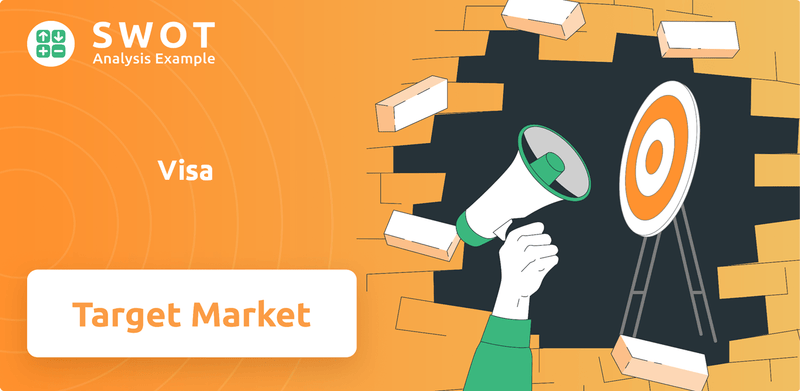
This analysis will dissect the Visa user base and Visa customer segmentation to reveal the nuances of its diverse clientele. We'll examine the demographics of Visa cardholders, including age, income, location, and spending habits. Furthermore, we will explore how Visa tailors its products and services to meet the evolving needs of its global customer base, ensuring its continued relevance in the dynamic payments landscape.
Who Are Visa’s Main Customers?
Understanding the primary customer segments of the payment giant is crucial for grasping its market position and strategic direction. The company operates as a payment network, connecting consumers, merchants, financial institutions, and governments. Its customer base is broad, encompassing both business-to-consumer (B2C) and business-to-business (B2B) segments, with a significant global presence.
On the B2C side, the company doesn't directly issue cards. Instead, it partners with financial institutions to provide credit, debit, and prepaid cards to consumers worldwide. This arrangement results in a diverse customer base that includes individuals of all ages, income levels, and occupations. The company's reach extends to both developed and emerging markets, with a strong focus on financial inclusion in the latter.
For B2B transactions, the company's direct customers are primarily financial institutions (issuers and acquirers), merchants, and governments. Financial institutions utilize the network to offer payment products, merchants rely on it for secure transactions, and governments use it for various programs. The company's growth strategy includes focusing on small and medium-sized businesses (SMBs) and cross-border B2B payments.
The company's customer base is incredibly diverse, reflecting its global reach. Its user base spans various age groups, from young adults to high-net-worth individuals. The company's target market includes a wide range of income levels, ensuring accessibility for many consumers.
The company's target market includes consumers, merchants, financial institutions, and governments. The company focuses on financial inclusion, especially in emerging markets. It also targets SMBs and cross-border B2B payments.
The user base is global, with billions of cards in use worldwide. The company's network supports transactions across various industries and geographies. The company's customer base is constantly evolving, adapting to changing market demands.
The company segments its customers based on demographics, spending habits, and industry. It also segments by the type of card used, such as credit, debit, or prepaid. Segmentation helps tailor products and services to specific customer needs.
The company's customer segmentation strategies are designed to maximize market penetration and customer satisfaction. These strategies involve understanding the diverse needs of consumers and businesses. The company focuses on providing secure, efficient, and innovative payment solutions to meet these needs.
- Consumers: Targeting various demographics with tailored card products and rewards programs.
- Merchants: Offering secure and efficient payment processing solutions for businesses of all sizes.
- Financial Institutions: Providing infrastructure and services to enable them to offer payment products.
- Governments: Supporting disbursement and collection programs.
The company continues to adapt to the evolving financial landscape, focusing on digital payments, fraud prevention, and data analytics. The company's ability to innovate and meet the needs of its diverse customer base is key to its continued success. For a deeper dive into the company's overall approach, consider reading about the Growth Strategy of Visa.
Visa SWOT Analysis
- Complete SWOT Breakdown
- Fully Customizable
- Editable in Excel & Word
- Professional Formatting
- Investor-Ready Format
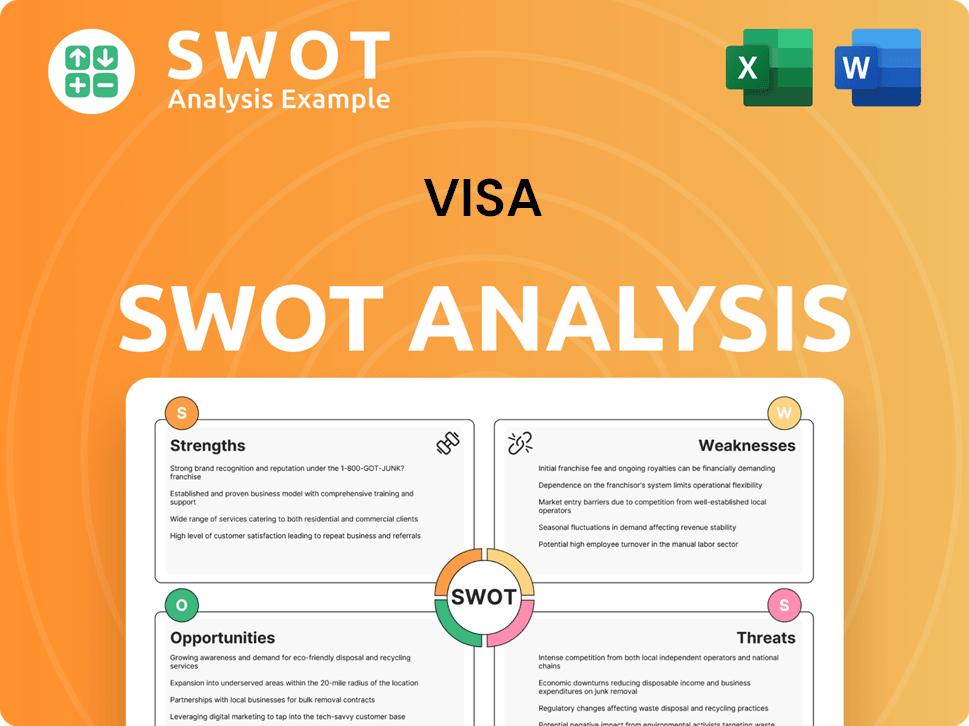
What Do Visa’s Customers Want?
Understanding the customer needs and preferences is crucial for the success of the [Company Name]. The primary drivers for customers choosing a [Company Name]-branded product are security, convenience, and global acceptance. This focus on customer needs allows [Company Name] to tailor its products and services to meet the evolving demands of its diverse user base.
Consumers are increasingly shifting towards digital and mobile payments, with a strong preference for contactless options and seamless checkout experiences. Loyalty factors for consumers are often tied to the benefits offered by their issuing financial institution, such as rewards programs and cashback, as well as the reliability of the [Company Name] network. Addressing these needs and preferences helps [Company Name] maintain its competitive edge in the payment industry.
For financial institutions and merchants, the motivations revolve around efficiency, reliability, and fraud prevention. Financial institutions need a robust and secure network to process transactions, manage risk, and offer competitive products to their customers. Merchants require fast and reliable payment processing, low transaction dispute rates, and access to a broad customer base. [Company Name] addresses these needs through continuous innovation and investment in security and payment solutions.
One of the primary needs for customers is the assurance of secure transactions. [Company Name] continually invests in advanced fraud detection technologies, such as its AI-powered fraud prevention tools, to address security needs and maintain trust within its ecosystem. This is a critical factor for both consumers and financial institutions.
Consumers highly value the ease of use for both in-person and online purchases. [Company Name] focuses on providing seamless checkout experiences, including contactless payment options. The simplicity and convenience of using [Company Name] cards drive customer satisfaction and loyalty.
The widespread acceptance of [Company Name] cards at millions of merchant locations worldwide is a significant advantage. This global reach allows users to make purchases virtually anywhere. This broad acceptance is a key factor in attracting and retaining customers.
Financial institutions need a robust and secure network to process transactions efficiently. [Company Name] provides the infrastructure and technology to support these needs, enabling financial institutions to manage risk and offer competitive products. This efficiency is crucial for their operations.
Merchants require fast and reliable payment processing to ensure smooth transactions and customer satisfaction. [Company Name] offers solutions that minimize transaction dispute rates and provide access to a broad customer base. Reliable processing is essential for merchants.
Merchants and financial institutions need data insights to optimize their business operations. [Company Name] provides tools and analytics to help them understand customer behavior and improve their services. Data-driven insights are key to business optimization.
To meet these diverse needs, [Company Name] employs several key strategies. These include continuous investment in security technologies, expansion of contactless payment options, and the development of solutions like [Company Name] Direct for real-time payments. These efforts are designed to cater to the growing demand for instant transfers and disbursements, which is a significant trend in the payment industry. For more details, you can read about the Revenue Streams & Business Model of Visa.
- Advanced Fraud Detection: [Company Name] utilizes AI-powered fraud prevention tools to protect transactions.
- Contactless Payments: Promoting and expanding contactless payment options to enhance convenience.
- Real-Time Payments: Developing solutions like [Company Name] Direct to facilitate instant transfers.
- Global Network: Maintaining a vast network of acceptance for worldwide use.
Visa PESTLE Analysis
- Covers All 6 PESTLE Categories
- No Research Needed – Save Hours of Work
- Built by Experts, Trusted by Consultants
- Instant Download, Ready to Use
- 100% Editable, Fully Customizable
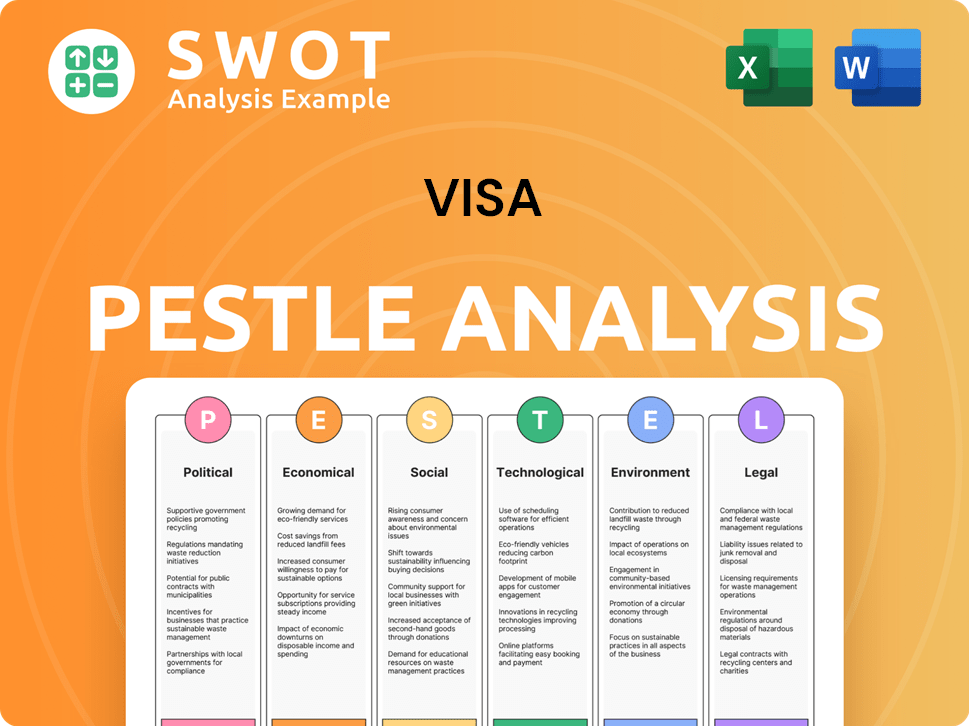
Where does Visa operate?
The geographical market presence of Visa is extensive, spanning over 200 countries and territories globally. This widespread reach is a key factor in its success, allowing it to serve a diverse customer base across various economic landscapes. Major markets include North America, Europe, Asia Pacific, Latin America, and CEMEA (Central Europe, Middle East, and Africa), each presenting unique opportunities and challenges.
Visa's strong market share and brand recognition are particularly evident in developed markets like the United States and Western Europe, where card penetration is high. However, the company also focuses on expanding its footprint in emerging markets, adapting its strategies to meet the specific needs of these regions. This includes tailoring products and services to local preferences and financial infrastructures.
Visa's approach to different regions involves adapting its offerings to local needs, which is crucial for maintaining its global leadership. For example, in Africa and Asia, Visa has introduced solutions like mVisa, designed for mobile payments. In Latin America, the company is actively promoting digital payments and e-commerce. Marketing Strategy of Visa plays a vital role in these expansions.
In North America, Visa benefits from high card penetration and a strong emphasis on digital wallets and contactless payments. The company continues to innovate with premium card benefits to cater to its customer demographics Visa. As of 2024, Visa remains a leading payment network in the U.S. with a significant share of card transactions.
Europe mirrors North America in its focus on digital payments and contactless technologies. Visa's strategy includes partnerships with local financial institutions to enhance its market presence. The Visa user base in Europe is diverse, with varying preferences across different countries.
The Asia Pacific region presents a rapidly growing market, with a strong emphasis on mobile-first payment solutions. Visa is actively involved in promoting financial inclusion and expanding its reach in this area. The Visa target market in this region is broad, including both urban and rural populations.
Latin America is a key growth area, with a focus on digital payments and e-commerce. Visa is expanding its presence by tapping into underserved populations and developing digital payment infrastructure. The company's customer segmentation strategies are tailored to the region's specific needs.
CEMEA is characterized by diverse markets, where Visa focuses on financial inclusion and mobile payment solutions. The company adapts its offerings to local market needs, including mVisa for mobile payments. Visa cardholders in this region benefit from tailored payment solutions.
Visa's geographic distribution of sales and growth continues to show robust expansion in developing economies as digital payments gain traction. While strategic withdrawals are less common, Visa continuously evaluates its market strategies to ensure relevance and effectiveness. Visa's customer acquisition strategies are also adapted to each region.
Visa Business Model Canvas
- Complete 9-Block Business Model Canvas
- Effortlessly Communicate Your Business Strategy
- Investor-Ready BMC Format
- 100% Editable and Customizable
- Clear and Structured Layout
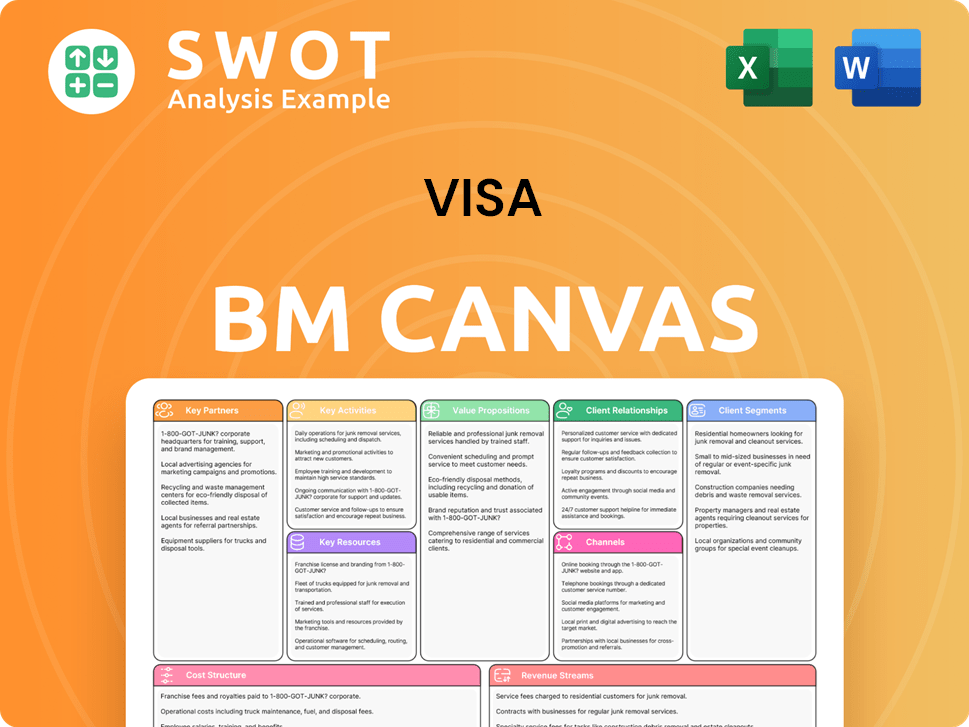
How Does Visa Win & Keep Customers?
The customer acquisition and retention strategies of the payment processing giant are primarily business-to-business (B2B) focused. The company targets financial institutions, merchants, and technology partners. These partners, in turn, acquire and retain end consumers. This approach allows the company to leverage its network and brand recognition to reach a vast and diverse customer base. Understanding the nuances of the Brief History of Visa helps to appreciate the evolution of these strategies.
For financial institutions, the company uses a combination of sales tactics, partnership programs, and technological innovation. They offer a comprehensive suite of products and services, including credit, debit, and prepaid card programs. Value-added services such as fraud management, data analytics, and consulting are also provided. Customer data and CRM systems are critical in segmenting financial institutions. This segmentation is based on their size, market focus, and strategic objectives. This allows the company to tailor its proposals and support.
To retain these partners, the company emphasizes the reliability, security, and global acceptance of its network. They also invest in joint marketing initiatives with financial institutions. These initiatives promote company-branded products to consumers. For merchants, the company collaborates with acquirers and payment facilitators. The goal is to ensure widespread acceptance of company cards and to introduce new payment technologies like tap-to-pay and QR code payments. Successful acquisition campaigns often demonstrate the tangible benefits of increased transaction volume, reduced fraud, and enhanced customer experience.
The company employs a direct sales force and relationship managers to engage with financial institutions. They offer customized solutions based on the institution's size and target market. Partnership programs provide incentives and support to encourage the adoption of company products. Technological innovation, such as advanced fraud prevention tools, is a key differentiator.
The company partners with acquirers and payment service providers (PSPs) to expand its merchant network. They provide marketing materials and training programs to help merchants understand the benefits of accepting company cards. The focus is on demonstrating how company acceptance can increase sales and improve customer experience.
The company collaborates with technology companies to integrate its payment solutions into new platforms and applications. They offer developer tools and APIs to facilitate these integrations. This approach expands the reach of company payments into new markets and use cases. The company actively seeks partnerships with fintech companies.
The company focuses on maintaining a reliable and secure payment network to retain its partners. They provide ongoing support and training to financial institutions and merchants. Loyalty programs and incentives are offered to encourage continued use of company products and services. The company invests heavily in fraud prevention and data security.
The company has increased its focus on digital payment solutions, including mobile payments, contactless payments, and online transactions. This shift aligns with evolving consumer preferences and the growth of e-commerce. They have invested in technologies like tokenization to enhance security for digital transactions.
The company actively fosters innovation through developer programs and open APIs. This allows third-party developers to create new payment solutions and integrate them with the company's network. This approach drives innovation and expands the company's ecosystem.
Cross-border payments are a significant area of focus, with the company facilitating transactions globally. They are working to streamline and improve the efficiency of international payments. The company leverages its global network to support cross-border transactions, offering competitive exchange rates.
The company aims to increase customer lifetime value by providing ongoing value and support to its partners. This includes offering new products and services, such as data analytics and consulting. They focus on building long-term relationships with financial institutions and merchants.
The company actively works to reduce churn within its partner ecosystem. This involves addressing any issues or concerns promptly and providing excellent customer service. They use data analytics to identify and address potential churn risks. They also offer incentives for long-term partnerships.
The company consistently updates its network capabilities, such as the VisaNet system, to ensure high transaction speeds and reliability. They invest in new technologies, such as artificial intelligence and machine learning, to enhance fraud detection and prevention. The company is at the forefront of payment technology innovation.
Visa Porter's Five Forces Analysis
- Covers All 5 Competitive Forces in Detail
- Structured for Consultants, Students, and Founders
- 100% Editable in Microsoft Word & Excel
- Instant Digital Download – Use Immediately
- Compatible with Mac & PC – Fully Unlocked
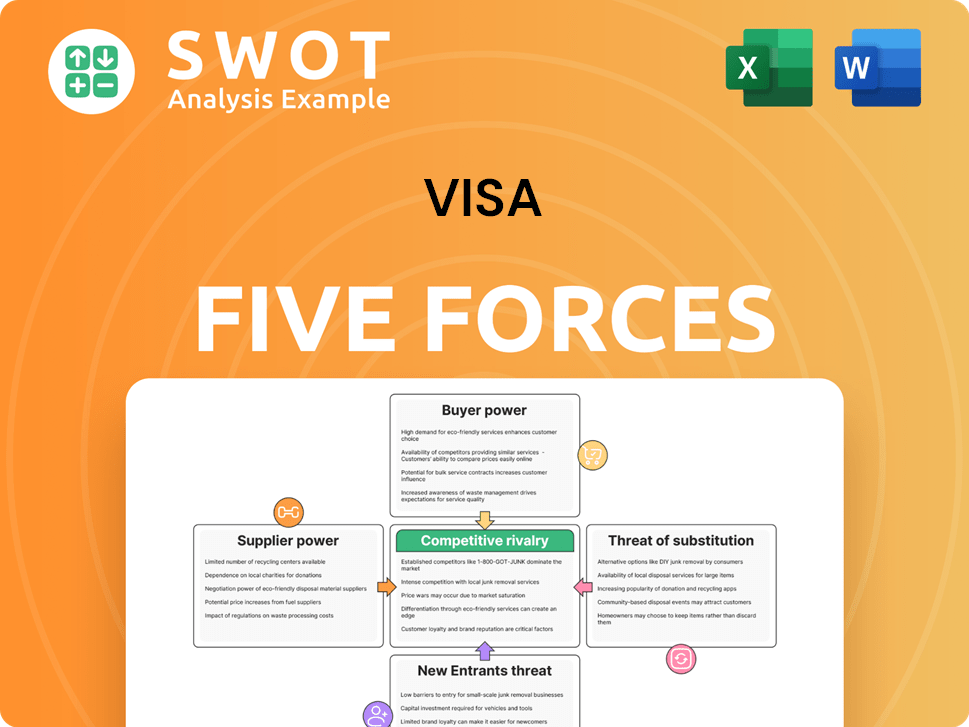
Related Blogs
- What are Mission Vision & Core Values of Visa Company?
- What is Competitive Landscape of Visa Company?
- What is Growth Strategy and Future Prospects of Visa Company?
- How Does Visa Company Work?
- What is Sales and Marketing Strategy of Visa Company?
- What is Brief History of Visa Company?
- Who Owns Visa Company?
Disclaimer
All information, articles, and product details provided on this website are for general informational and educational purposes only. We do not claim any ownership over, nor do we intend to infringe upon, any trademarks, copyrights, logos, brand names, or other intellectual property mentioned or depicted on this site. Such intellectual property remains the property of its respective owners, and any references here are made solely for identification or informational purposes, without implying any affiliation, endorsement, or partnership.
We make no representations or warranties, express or implied, regarding the accuracy, completeness, or suitability of any content or products presented. Nothing on this website should be construed as legal, tax, investment, financial, medical, or other professional advice. In addition, no part of this site—including articles or product references—constitutes a solicitation, recommendation, endorsement, advertisement, or offer to buy or sell any securities, franchises, or other financial instruments, particularly in jurisdictions where such activity would be unlawful.
All content is of a general nature and may not address the specific circumstances of any individual or entity. It is not a substitute for professional advice or services. Any actions you take based on the information provided here are strictly at your own risk. You accept full responsibility for any decisions or outcomes arising from your use of this website and agree to release us from any liability in connection with your use of, or reliance upon, the content or products found herein.